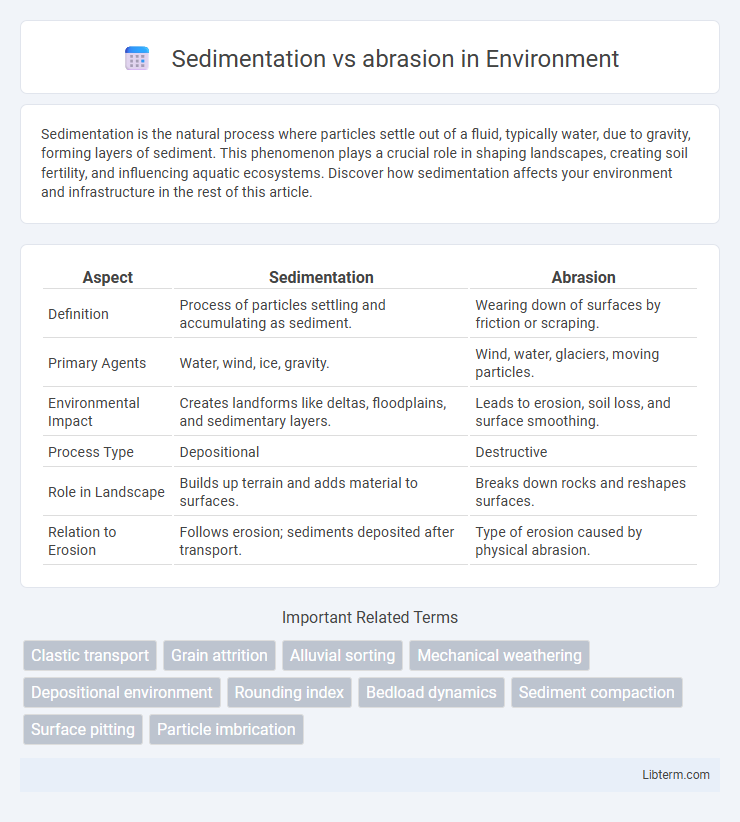Sedimentation is the natural process where particles settle out of a fluid, typically water, due to gravity, forming layers of sediment. This phenomenon plays a crucial role in shaping landscapes, creating soil fertility, and influencing aquatic ecosystems. Discover how sedimentation affects your environment and infrastructure in the rest of this article.
Table of Comparison
| Aspect | Sedimentation | Abrasion |
|---|---|---|
| Definition | Process of particles settling and accumulating as sediment. | Wearing down of surfaces by friction or scraping. |
| Primary Agents | Water, wind, ice, gravity. | Wind, water, glaciers, moving particles. |
| Environmental Impact | Creates landforms like deltas, floodplains, and sedimentary layers. | Leads to erosion, soil loss, and surface smoothing. |
| Process Type | Depositional | Destructive |
| Role in Landscape | Builds up terrain and adds material to surfaces. | Breaks down rocks and reshapes surfaces. |
| Relation to Erosion | Follows erosion; sediments deposited after transport. | Type of erosion caused by physical abrasion. |
Overview of Sedimentation and Abrasion
Sedimentation is the geological process where particulate matter settles and accumulates on surfaces, often forming sediment layers through deposition by water, wind, or ice. Abrasion involves the mechanical wearing down of rock surfaces due to friction and impact from particles carried by natural agents like water flow or glaciers. Both processes play critical roles in shaping landscapes but differ fundamentally as sedimentation builds up material while abrasion breaks it down.
Definitions: Sedimentation vs Abrasion
Sedimentation is the geological process where particles settle out of a fluid, typically water or air, and accumulate to form sediment layers. Abrasion refers to the mechanical wearing down of surfaces through friction or rubbing, often caused by particles being transported by wind, water, or ice. Both processes play crucial roles in shaping landscapes, with sedimentation building up deposits and abrasion eroding rocks and other materials.
Key Processes Involved
Sedimentation involves the deposition of particles transported by water, wind, or ice, leading to the accumulation of sediments in layers. Abrasion occurs when particles scrape, grind, or wear down surfaces through friction during transport. Both processes shape geological formations, with sedimentation building up materials and abrasion eroding them.
Factors Influencing Sedimentation
Sedimentation is primarily influenced by factors such as particle size, water velocity, and the chemical composition of the sediment, which dictate the rate and extent of deposition. Abrasion differs as it involves the mechanical wearing down of particles caused by friction and collision during transport, often impacting sediment shape rather than accumulation. Understanding these factors is essential for predicting sedimentary environments and managing erosion in rivers, coastal areas, and reservoirs.
Factors Affecting Abrasion
Abrasion is primarily influenced by factors such as the hardness and size of the particles involved, the velocity of the transporting medium, and the surface characteristics of the material being abraded. Higher particle hardness and increased transport velocity typically result in more intense abrasion, while smoother surfaces tend to experience less wear. Environmental conditions, including moisture and temperature, also impact the rate and extent of abrasion during geological processes.
Environmental Impact Comparison
Sedimentation increases nutrient loading in aquatic ecosystems, often causing eutrophication and habitat disruption, while abrasion primarily affects physical landscapes through soil erosion and degradation of rock surfaces. Sediment accumulation can smother benthic organisms and reduce water quality, whereas abrasion leads to sediment particles entering waterways, further contributing to turbidity and sedimentation downstream. Both processes alter ecosystems, but sedimentation tends to drive chemical and biological changes, whereas abrasion mainly induces physical and structural environmental impacts.
Industrial and Natural Settings
Sedimentation involves the accumulation of particles transported by wind, water, or ice, forming layers that consolidate into sedimentary rocks in both industrial settings like wastewater treatment and natural environments such as riverbeds. Abrasion refers to the mechanical scraping or wearing down of surfaces due to friction between particles or against machinery, crucial in equipment maintenance in mining operations and shaping landscapes in natural settings like glacial movement. Understanding the balance between sedimentation and abrasion is essential for optimizing industrial processes and managing erosion and deposition in ecosystems.
Examples and Case Studies
Sedimentation processes are exemplified by the formation of the Mississippi River Delta, where layers of silt and clay accumulate over thousands of years, creating extensive wetland habitats. In contrast, abrasion is evident in the Grand Canyon, where the Colorado River's continuous flow has worn down rock surfaces, carving deep channels through sedimentary layers. Case studies from coastal regions like the White Cliffs of Dover highlight abrasion from wave action eroding chalk cliffs, while sedimentation is documented in the Nile Delta, showing deposition of nutrient-rich sediments supporting agriculture.
Prevention and Mitigation Strategies
Sedimentation prevention strategies include controlling soil erosion through vegetation cover, implementing silt fences, and using sediment basins to capture and filter runoff before it reaches water bodies. Abrasion mitigation involves selecting wear-resistant materials, applying surface treatments like coatings or liners, and maintaining equipment regularly to reduce friction and wear. Employing combined approaches such as proper land management and equipment design enhances overall durability and minimizes environmental impact.
Summary: Choosing Between Sedimentation and Abrasion
Sedimentation involves the gradual accumulation of particles settling from a fluid, while abrasion refers to the mechanical wearing down of surfaces through friction. Selecting between sedimentation and abrasion depends on the specific application requirements, such as the desired surface finish, material durability, and environmental conditions. Understanding the interaction of materials with their surroundings helps optimize processes in industries like geology, manufacturing, and environmental engineering.
Sedimentation Infographic

 libterm.com
libterm.com